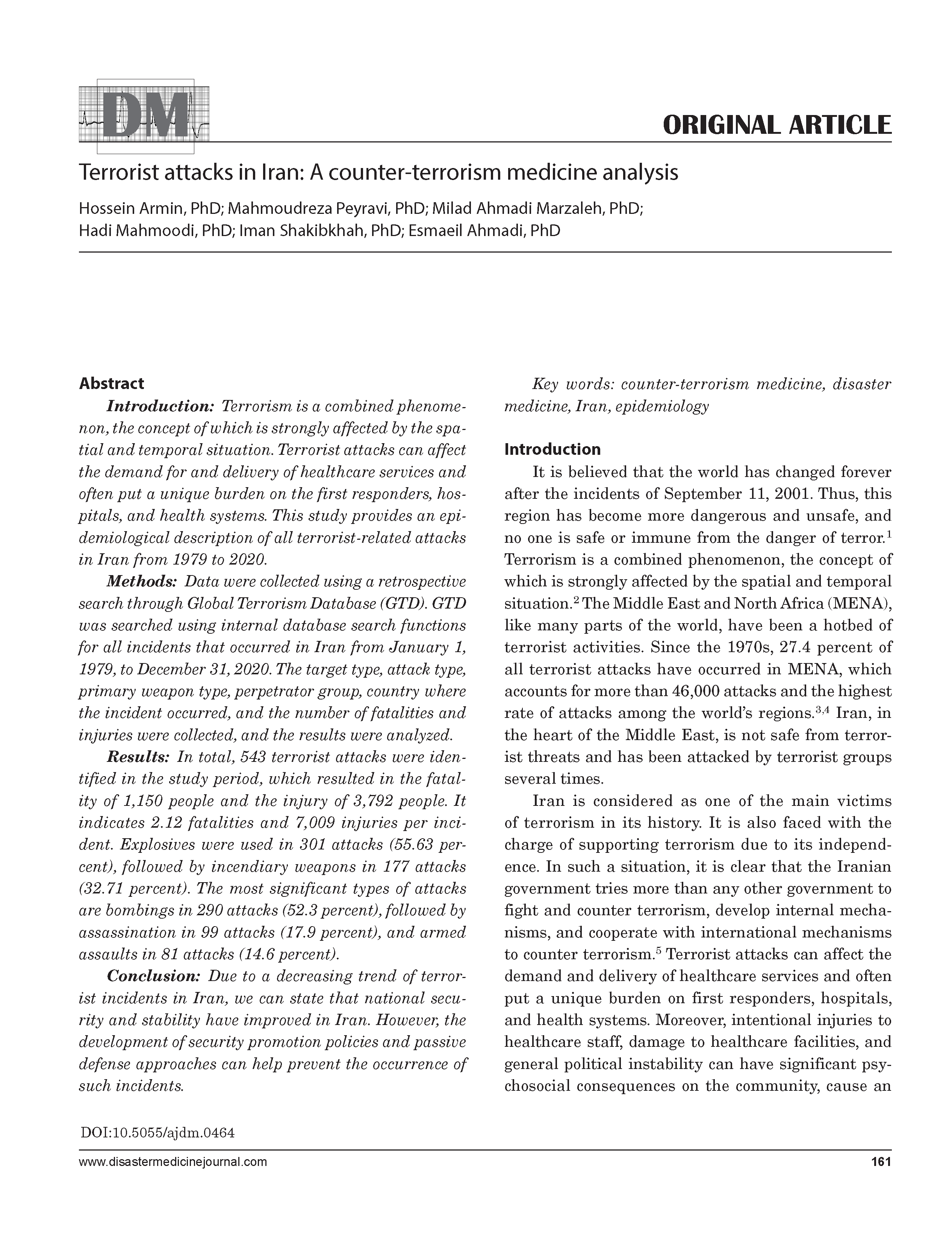Terrorist attacks in Iran: A counter-terrorism medicine analysis
DOI:
https://doi.org/10.5055/ajdm.0464Keywords:
counter-terrorism medicine, disaster medicine, Iran, epidemiologyAbstract
Introduction: Terrorism is a combined phenomenon, the concept of which is strongly affected by the spatial and temporal situation. Terrorist attacks can affect the demand for and delivery of healthcare services and often put a unique burden on the first responders, hospitals, and health systems. This study provides an epidemiological description of all terrorist-related attacks
in Iran from 1979 to 2020.
Methods: Data were collected using a retrospective search through Global Terrorism Database (GTD). GTD was searched using internal database search functions for all incidents that occurred in Iran from January 1, 1979, to December 31, 2020. The target type, attack type, primary weapon type, perpetrator group, country where the incident occurred, and the number of fatalities and injuries were collected, and the results were analyzed.
Results: In total, 543 terrorist attacks were identified in the study period, which resulted in the fatality of 1,150 people and the injury of 3,792 people. It indicates 2.12 fatalities and 7,009 injuries per incident. Explosives were used in 301 attacks (55.63 percent), followed by incendiary weapons in 177 attacks (32.71 percent). The most significant types of attacks are bombings in 290 attacks (52.3 percent), followed by assassination in 99 attacks (17.9 percent), and armed assaults in 81 attacks (14.6 percent).
Conclusion: Due to a decreasing trend of terrorist incidents in Iran, we can state that national security and stability have improved in Iran. However, the development of security promotion policies and passive defense approaches can help prevent the occurrence of such incidents.
References
Al-Dahash H, Kulatunga U, Thayaparan M: Weaknesses during the disaster response management resulting from war operations and terrorism in Iraq. Int J Disaster Risk Reduction. 2019; 34: 295-304.
Saifi SSS, Hassan J, Mohsen K: Terrorist thinking untile to thinking terror. In The 9th Congress of Progress Pioneers, Tehran, Iran, 2015: 370-378.
Tin D, Margus C, Ciottone GR: Half-a-century of terrorist attacks: Weapons selection, casualty outcomes, and implications for counterterrorism medicine. Prehosp Disaster Med. 2021; 36(5): 526-530.
Tin D, Fares S, Al Mulhim M, et al.: Terrorist attacks in the Middle East: A counter-terrorism medicine analysis. Prehosp Disaster Med. 2022; 37(2): 212-216.
Salehi H, Asgarkhani A, Salahi S: Iran’s strategy for combatting the financing of terrorism. Iranian Polit Res. 2022; 9(32): 33-54.
Safeguarding Health in Conflict Coalition: Health workers at risk: violence against health care. 2020.
Gunaratna R: Bruce Hoffman: Inside Terrorism. New York: Columbia University Press, 2006; Milton Park: Taylor & Francis, 2008.
Webb JJ, Cutter SL: The geography of US terrorist incidents, 1970–2004. Terror Political Violence. 2009; 21(3): 428-449.
Schuurman B: Topics in terrorism research: Reviewing trends and gaps, 2007-2016. Crit Stud Terror. 2019; 12(3): 463-480.
Marzaleh MA, Mahmoodi H, Armin H, et al.: Terrorist attack in ShahCheragh, Iran: Planning for the future. Prehosp Disaster Med. 2023; 1-2. DOI: 10.1017/S1049023X22002461.
Shayan F: The function of the terrorists of the army of god group in Sistan & Balochistan. Polit Stud Islamic World. 2022; 10(4): 51-65.
Shariati S, Vazirian AH: Counterterrorism in Middle Eastern Foreign Policy of Iran (1972-2021). Geopolit Q. 2022; 12(3): 1-15.
Jiang Z: Confrontations on the issue of terrorism between Iran and the US after 1979. Terror Polit Violence. 2017; 29(2): 236-253.
Etaat J, Dabiri A, Taheri A, et al.: Spatial-temporal pattern analysis of terrorist attacks in Iran (1357-1397). Geopolit Q. 2023; 19(69): 152-175.
Global Terrorism Database (GTD): Available at https://www.start.umd.edu/data-tools/global-terrorism-database-gtd. Accessed July 18, 2021.
National Consortium for the Study of Terrorism and Responses to Terrorism (START): Codebook: Inclusion criteria and variables. College Park, MD: START, 2019.
Anderson M: Terrorist killings up by 80 percent in 2014, fueling flow of refugees. The Guardian. 2015.
Omidi A, Mobini Z: A discourse analysis of the conflicting implications of terrorism: The Iranian and US perspectives. Chin Polit Sci Rev. 2022; 7(4): 484-502.
Malakoutikhah Z: Iran: Sponsoring or combating terrorism? Stud Conflict Terror. 2020; 43(10): 913-939.
Jost J: Institute for Economics & Peace: Global terrorism index 2015. SIRIUS-Zeitschrift für Strategische Analysen. 2017; 1(1): 91-92.
McCann WS: Who said we were terrorists? Issues with terrorism data and inclusion criteria. Stud Conflict Terror. 2020; 46: 964-984.
Shin H, Hertelendy AJ, Hart A, et al.: Terrorism-related attacks in East Asia from 1970 through 2020. Prehosp Disaster Med. 2023; 38(2): 232-236.

Published
How to Cite
Issue
Section
License
Copyright 2007-2025, Weston Medical Publishing, LLC and American Journal of Disaster Medicine. All Rights Reserved.

